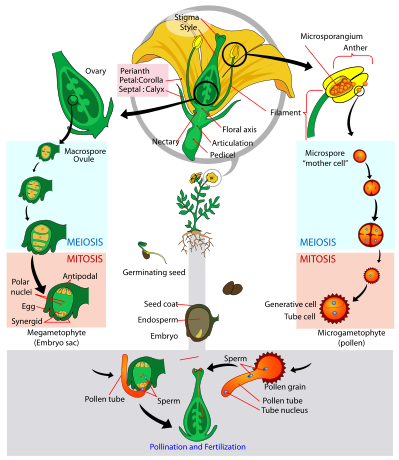
Reproduction
The peanut, like all angiosperms, possess an alternation of generation life cycle. An alternation of generations means the plant, in this case the peanut, switches between the haploid (n) and diploid (2n) stages during its life. A haploid cell has half the normal number of chromosomes for a particular organism and needs to fuse with another haploid cell in order to continue on with its life cycle. Simply put, the haploid cell is the reproductive cell. The diploid cell, on the other hand, has a full set of chromosomes. In the peanut, the diploid sporophyte phase is the more dominant of the two phases. The haploid gametophyte is small and nutritionally dependent on the sporophyte.
Peanuts are self-pollinating plants, meaning they do not require outside aid, such as bees or other insects carrying pollen from one plant to another, in reproduction. After the seed is planted, the first flowers begin to appear in four to six weeks and continue blooming for six or more weeks. As each flower grows older, it drops closer and closer to the ground so that, when it does come time to pollinate, the ovary is close to the ground to allow for easy insertion of the subterranean pod. When it is time to start pollinating, one and only one flower opens at sunrise and releases its pollen. There can be anywhere between one and several days between each flower blooming. Fertilization of the seed takes place between eight and nine hours after the pollen is released. Eight to 14 days after fertilization occurs, the ovary elongates into a peg, is driven vertically into the ground, and turns horizontal. Underground, the horizontal peg matures into a pod and, after seven to nine weeks, becomes the peanut we all recognize. It is for this underground ripening that the peanut was given its scientific name, as explained under classification.
 This
is a picture of the flower of the peanut plant. Between now and
fertilization, it will drop a bit so it is closer to the ground.
This
is a picture of the flower of the peanut plant. Between now and
fertilization, it will drop a bit so it is closer to the ground.
